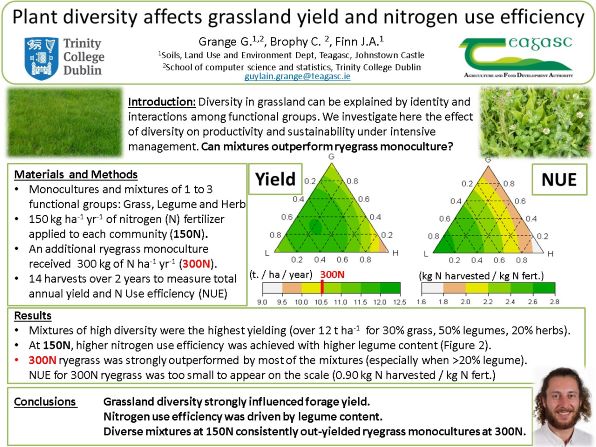Poster 3
Title: Plant diversity affects grassland yield and nitrogen use efficiency
Authors: G. Grange1,2, J.A. Finn1 and C. Brophy2
Organisation: 1Teagasc, 2Trinity College Dublin
For the pdf version of the poster (click here).

If you would like to ask the author a question about their poster, please post it below.
Comments will be moderated before they are published.


Great poster. A few questions.
– What was the soil type?
– What grass-legume-herb mixtures were used?
– Which legume-herb species persisted the best?
– Presumably the 14 harvests over 2 years were taken April to October in each year?
– How much summer rainfall fell in each year?
Thanks,
Paul
Hi Paul, thanks for the questions.
– Soil type was sandy loam, pH 5.6. Previous cover was long term ryegrass pasture.
– Grass species were ryegrass and timothy (Lolium perenne and phleum pratense), legume species were red and white clover (trifolium pratense and repens) and herb species were ribwort plantain and chicory (plantago lanceolate and cichorium intybus). Cultivars were chosen among the highest performing ones in the Dept. of Agriculture recommended list.
– White clover and plantain had higher persistence in this field, but in another field with lower soil fertility and longer regrowth period, all species persisted well.
– Yes, first cut was done around the 25th of March and last one around 20th of October.
– Both years had about 950mm rainfalls… but much less over the growing period (approx. 400-500mm). Plots were watered in summer 2018 to attain 100mm over the summer. This was to create a water supply gradient as we also had plots were summer drought was applied.
for more information on this topic, please visit the paper that will come out soon: “Plant diversity enhanced yield and mitigated drought impacts in intensively managed grassland communities” by Grange, Brophy and Finn.
Are the results identical at 0N ?
Hi Victor,
There was no modality at 0N. Although it would have been interesting from an ecological perspective, we focus here on intensively managed grassland. The 150N is an approximation of animal deposition in case of a stocking rate of 2-2.5 LU/ha, corresponding to local practices (South-East of Ireland). We show that diversity can help displacing mineral N fertilisation while maintaining yield.
For further information on the effect of legume in displacing N fertiliser, you can visit the paper from Nyfeler et al (2009) “Strong mixture effects among four species in fertilized agricultural grassland led to persistent and consistent transgressive overyielding ”
Hoping this was helpful.